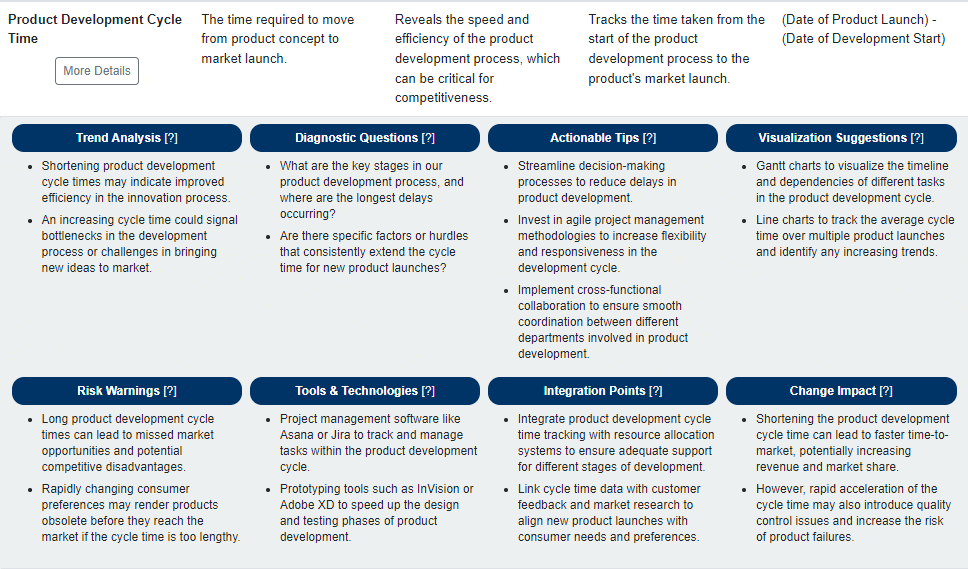Editor's Note: Take a look at our featured best practice, Cost Segregation Study: Multiple Property Class Analysis (Excel workbook). Accountants, accounting firms, and real estate property owners can all benefit from this cost segregation study (CSS) template. It makes the estimated benefit easy to figure out and has flexible assumptions for high level or detailed segregation analysis. You get a summary of cost [read more]
KPI Management: New Product Development KPIs
* * * *

NPD is central to organizations looking to maintain or establish a competitive edge, enabling them to capitalize on emerging opportunities and meet evolving customer demands. In the context of strategic planning and performance management, NPD plays a vital role in determining an organization’s long-term success and market positioning.
The objective of this article is to highlight the significance of New Product Development within organizations, focusing on how Key Performance Indicators (KPIs) associated with NPD can guide strategic decision-making, facilitate effective strategy formulation, and drive operational enhancements. By exploring these KPIs, we aim to provide insights that enable startups, entrepreneurs, and established businesses to optimize their product development processes, thereby accelerating growth and fostering innovation.
Criticality of New Product Development
In an era defined by rapid technological advancements and shifting consumer preferences, the ability to innovate through New Product Development is more crucial than ever. NPD allows organizations to respond proactively to market trends, leverage new technologies, and address unmet customer needs, ultimately contributing to revenue growth and brand differentiation.
Effective NPD processes not only bring new products to market but also ensure these products are aligned with strategic business objectives and customer expectations.
The Difficulties to Excellent Product Development
Despite its importance, New Product Development is fraught with challenges, including managing the inherent risks of innovation, aligning NPD processes with business strategy, ensuring cross-functional collaboration, and meeting the time-to-market demands. Additionally, companies must navigate the complexities of resource allocation, market validation, and regulatory compliance.
KPIs within the NPD functional group provide a framework for navigating these challenges, offering insights into the effectiveness of NPD initiatives, the efficiency of development processes, and the impact of new products on market share and customer satisfaction. By leveraging these KPIs, companies can refine their NPD strategies, enhance product innovation, and sustain competitive advantage in their respective markets.
Top 10 New Product Development (NPD) KPIs
Focusing on impactful KPIs is essential for optimizing New Product Development processes and achieving successful market outcomes. Here are the top 10 KPIs crucial for New Product Development. These KPIs are selected from the Flevy KPI Library, a robust database of over 15,000+ KPIs.
1. Product Development Cycle Time
- Definition: The time taken from the initial idea generation to the market launch of a new product.
- Relevance: Shorter cycle times can lead to faster market entry, providing a competitive advantage and better alignment with customer needs.
2. New Product Success Rate
- Definition: The percentage of new products that meet or exceed their performance and financial goals.
- Relevance: Indicates the effectiveness of the NPD process and the organization’s ability to deliver products that resonate with the market.
3. Time to Market for New Products
- Definition: The duration from product conception to its launch in the market.
- Relevance: Critical for capturing market opportunities and meeting consumer demands in a timely manner.
4. New Product Revenue
- Definition: The total revenue generated from new products within a specific period after launch.
- Relevance: Reflects the market acceptance and financial impact of new products on the organization’s overall revenue.
5. Customer Satisfaction with New Products
- Definition: Measures how well new products meet or exceed customer expectations.
- Relevance: High customer satisfaction is key to establishing product credibility and fostering long-term loyalty.
6. New Product Market Share
- Definition: The market share captured by new products in their respective categories.
- Relevance: Provides insights into the competitive performance of new products and their impact on the organization’s market positioning.
7. R&D Spend on New Product Development
- Definition: The portion of R&D expenditure allocated specifically to the development of new products.
- Relevance: Indicates the organization’s commitment to innovation and its potential for future growth through NPD.
8. Cross-Functional Collaboration Index
- Definition: A measure of the effectiveness of collaboration among different departments involved in the NPD process.
- Relevance: Enhances the efficiency and quality of product development, leveraging diverse expertise and perspectives.
9. Idea-to-Launch Success Rate
- Definition: The ratio of successful product launches to the total number of product ideas or concepts initiated.
- Relevance: Helps in evaluating the organization’s capability to filter and prioritize ideas that lead to successful products.
10. Environmental Impact of New Products
- Definition: Assesses the environmental sustainability of new products throughout their lifecycle.
- Relevance: Aligns with increasing consumer demand for environmentally responsible products and supports corporate sustainability goals.
To dig deeper into any of these KPIs, we invite you to explore the Flevy KPI Library, which allows you to drill down into 12 attributes for each KPI in the database. Here is an example for our top ranked KPI, Product Development Cycle Time:
NPD Case Studies and Success Stories
Accelerating Success through Reduced Product Development Cycle Time
A consumer electronics company faced the challenge of long “Product Development Cycle Times,” which delayed market entry and resulted in lost opportunities. To maintain competitiveness, the company prioritized reducing cycle times without compromising on product quality.
The organization streamlined its product development process by enhancing “Cross-Functional Collaboration” and adopting agile methodologies. By setting clear milestones and leveraging real-time communication tools, the company was able to make quicker decisions and accelerate development phases.
Outcome: The focused effort led to a significant reduction in product development cycle time, allowing the company to launch products faster. This strategic change not only improved the “Time to Market for New Products” but also positively impacted the “New Product Success Rate,” as products were more aligned with current market trends and customer demands.
Lessons Learned: Streamlining the product development process and fostering cross-functional collaboration are key to reducing time to market. An agile approach enables organizations to adapt quickly to changes, ensuring new products are both innovative and timely.
Enhancing Market Impact with Customer-Centric New Products
Facing stagnation in market share, a software development firm decided to revamp its approach to New Product Development, placing a greater emphasis on “Customer Satisfaction with New Products.” The goal was to create products that more accurately addressed customer needs and preferences.
The company instituted a comprehensive customer feedback loop early in the development process and integrated “Customer Satisfaction” metrics into its performance evaluation for new products. It also increased its “R&D Spend on New Product Development” to support more in-depth market analysis and prototype testing.
Outcome: By prioritizing customer satisfaction and aligning investment in R&D, the firm launched a series of highly successful products that received positive market reception. This led to significant increases in “New Product Revenue” and “New Product Market Share,” reflecting the effectiveness of customer-driven development strategies.
Lessons Learned: Incorporating customer feedback early and throughout the product development process can greatly enhance the market success of new products. Adequate investment in R&D, focused on understanding and meeting customer needs, is critical for developing products that stand out in competitive markets.
Additional Resources and Further Reading
Foremost, if you are in the process of selecting or refreshing your Innovation Management KPIs, take a look at the Flevy KPI Library. With over 15,000+ KPIs, our KPI Library is one of the largest databases available. Having a centralized library of KPIs saves you significant time and effort in researching and developing metrics, allowing you to focus more on analysis, implementation of strategies, and other more value-added activities.
Here are other KPI Strategy and KPI Management articles we’ve published:
- Principles of KPI Selection. This article breaks down the 8 guiding principles to KPI selection and provides several case studies on how to use these principles in practice.
- Principles of KPI Maintenance. It’s important to recognize that as market conditions and strategic objectives evolve, so too must the KPIs. This article provides a disciplined approach to maintaining KPIs.
- KPI Dashboard Design & Visualization. Learn the art and science of designing KPI dashboards, including types of data visualization and how to choose among them.
- Anatomy of a Strong KPI. Learn what makes a KPI effective, discussing the characteristics of KPIs that are most impactful and how they can drive strategic business decisions.
- 10 Common Pitfalls in KPI Implementation. Learn how to identify and remediate the 10 most common pitfalls in KPI implementation. If left unfixed or as unknowns, these pitfalls can have disastrous, long-term impacts on the organization.
- KPIs and Organizational Alignment . This article discusses the concepts of strategic, tactical, and operational KPIs; as well as balancing individual, team, and organizational objectives.
- Integrating KPIs into Employee Performance. This article discusses 5 methods for integrating KPIs into individual performance metrics; and includes several case studies.
- Integrating KPIs into the Organizational Culture. This article breaks down 4 strategies for embedding KPIs into the Corporate Culture; also includes several case studies.
- Future-Proofing KPIs. Understand how to “future-proof” KPIs by understanding the impacts of emerging market trends, emerging technologies, and evolving consumer behaviors on KPIs.
- KPIs and Digital Transformation. All organizations are undergoing Digital Transformations. Learn how to define, select, and implement relevant Digital Transformation KPIs.

Do You Want to Implement Business Best Practices?
You can download in-depth presentations on 100s of management topics from the FlevyPro Library. FlevyPro is trusted and utilized by 1000s of management consultants and corporate executives.
For even more best practices available on Flevy, have a look at our top 100 lists:
- Top 100 in Strategy & Transformation
- Top 100 in Digital Transformation
- Top 100 in Operational Excellence
- Top 100 in Organization & Change
- Top 100 Management Consulting Frameworks
These best practices are of the same as those leveraged by top-tier management consulting firms, like McKinsey, BCG, Bain, and Accenture. Improve the growth and efficiency of your organization by utilizing these best practice frameworks, templates, and tools. Most were developed by seasoned executives and consultants with over 20+ years of experience.
Readers of This Article Are Interested in These Resources

|
|
145-slide PowerPoint presentation
|
|
Excel workbook
| |||
About Flevy Management Insights
Top 10 Recommended Documents














